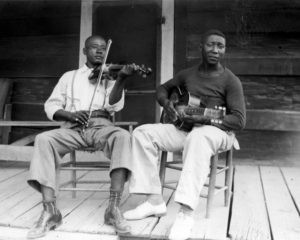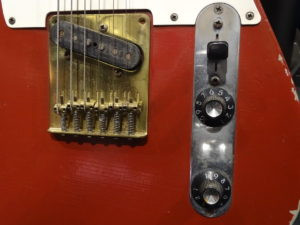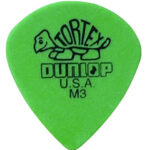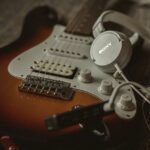Muddy Waters, a titan of the blues, shaped the genre for over four decades, moving from plantation porches to global stages. His evolving sound was intrinsically linked to the guitars he wielded, each playing a crucial role in his musical journey. From humble acoustics to iconic electric models, Waters amassed a collection that mirrored his dynamic career. This exploration delves into the world of Waters Guitar and the specific instruments that defined the sound of a blues legend.
Waters’ journey with the guitar began humbly. At 17, he acquired his first guitar, a Stella acoustic, for a mere $2.50 from the Sears catalog. This Stella became his foundational instrument, the tool he used to learn the riffs of Robert Johnson and absorb the live performances of Son House in the heart of the Mississippi Delta. It was on this very waters guitar, a simple Stella acoustic, that the seeds of a blues revolution were sown.
 Son Sims and Muddy Waters
Son Sims and Muddy Waters
Image: Son Sims and Muddy Waters pictured together in 1942, with Waters holding a resonator guitar, showcasing early instruments in his career.
In the early 1940s, ethnomusicologist Alan Lomax documented Waters’ music for the Library of Congress. During the 1941 sessions, Waters played a Martin acoustic, borrowed from Lomax himself, highlighting the early acoustic phase of his career. The following year, in 1942, a photograph captured Waters with Henry “Son” Sims, holding a resonator guitar of unknown origin, reflecting the resourceful nature of blues musicians at the time. Upon his move to Chicago in 1943, a Silvertone acoustic guitar became his companion, continuing his acoustic explorations before the electric revolution beckoned.
Recognizing the need to amplify his sound in the bustling Chicago clubs, Waters transitioned to electric guitars in 1944. His first electric waters guitar, played through portable amplifiers, marked a pivotal shift. His setup remained straightforward: a capo, slide, and fingerpicks, prioritizing raw expression over elaborate gear.
A turning point arrived when Waters began recording for Aristocrat Records. His first electric guitar had been stolen, leading him to acquire a Gretsch Synchromatic. Influenced by Jimmy Rogers, Waters equipped the Gretsch with a D’Armond FHC pickup to electrify it, a modification that would define his early electric blues sound. Groundbreaking hits like “I Can’t Be Satisfied,” “I Feel Like Going Home,” and “Rollin’ Stone” – the latter recorded after Aristocrat became Chess Records – were all born from this modified Gretsch, solidifying its place in blues history as a key Waters guitar.
The early 1950s saw another significant shift in Waters’ choice of waters guitar. He adopted a 1952 Gibson Les Paul Gold Top, equipped with powerful P-90 pickups. This Les Paul became his primary instrument until 1957, a period of intense creativity and iconic recordings. Despite Chess Records primarily releasing blues on singles during this era, Waters unleashed a torrent of influential songs on this Gibson, including blues standards such as “Turn the Lamp Down Low (Baby Please Don’t Go),” “I’m Your Hoochie Coochie Man,” “Forty Days and Forty Nights,” and “Got My Mojo Working.” This Gold Top Les Paul, an iconic Waters guitar, is rumored to have passed through the hands of blues and rock legends like B.B. King, Eric Clapton, and Peter Green, though its current whereabouts remain a mystery, adding to its legendary status.
 Muddy_Waters_1958_Fender_Telecaster_GuitarRock_&_Roll_Hall_of_Fame_Adam_Jones
Muddy_Waters_1958_Fender_Telecaster_GuitarRock_&_Roll_Hall_of_Fame_Adam_Jones
Image: Close-up of Muddy Waters’ iconic 1958 Fender Telecaster “The Hoss” at the Rock & Roll Hall of Fame, highlighting the details of this legendary instrument.
In 1957, Waters acquired a brand new 1958 Fender Telecaster, which would become his most recognizable and enduring waters guitar. Originally white with a maple neck, this Telecaster underwent several modifications. In 1961, he replaced the maple neck with a rosewood one, had the guitar refinished in candy apple red, and swapped the knobs with amplifier knobs, personalizing it to his exact preferences. Nicknamed “The Hoss,” this Telecaster became Muddy Waters’ main workhorse guitar until his passing in 1983. “Hoss” was the Waters guitar he played during the Rolling Stones’ visit to Buddy Guy’s Checkerboard Lounge in 1981, a legendary blues moment. It also featured prominently on his commercially successful album Fathers and Sons (1969) and would have been used on Electric Mud and the Grammy-winning Hard Again, although he may not have actually played on those recordings. In a remarkable turn of events, “The Hoss” was returned to Muddy Waters’ family in 2017, ensuring its legacy within his lineage.
While the candy apple red Telecaster became synonymous with Muddy Waters in his later years, he also used other guitars throughout the 1960s. Despite the album cover of At Newport 1960 featuring him with a Harmony Monterey archtop, it was actually “The Hoss” Telecaster he played at the Newport performance. The Harmony Monterey in fact belonged to John Lee Hooker, who also performed at the festival with Waters’ band backing him, creating a visual misdirection in Waters guitar history. For his Folk Singer album (1964) and the 1968 Newport Folk Festival, Waters favored a 1959 Martin 00-18E acoustic/electric guitar, showcasing his continued connection to acoustic instruments. This Martin guitar is now preserved at the Rock and Roll Hall of Fame Museum.
During his 1965 Carnegie Hall performance, Waters played a Gibson SG Junior. A short-lived endorsement deal with Guild guitars in the 60s also saw him playing 1963 and 1966 Guild Thunderbird S-200s, one in cherry sunburst and the other in ebony grain, both equipped with single-coil pickups, demonstrating his willingness to experiment with different waters guitar models.
 muddy-waters-live-at-newport
muddy-waters-live-at-newport
Image: Muddy Waters performing live at Newport, showcasing his dynamic stage presence and the use of his signature Telecaster during performances.
While not defined by a single iconic guitar like B.B. King’s “Lucille,” Muddy Waters’ diverse arsenal of acoustic and electric waters guitar models played an essential role in shaping his thunderous, electrified Delta blues sound. Each instrument contributed a unique voice to his evolving musical narrative, cementing his status as a true innovator and legend of the blues.


